上海版牛津英语4A教案(最新整理)
- 格式:pdf
- 大小:471.43 KB
- 文档页数:100
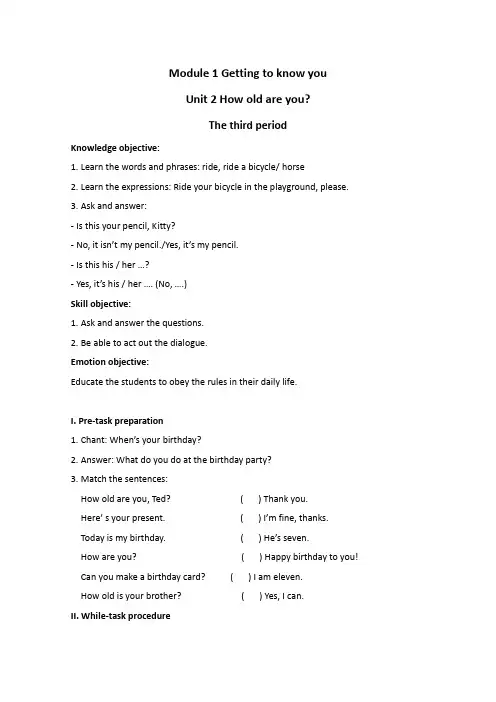
Module 1 Getting to know youUnit 2 How old are you?The third periodKnowledge objective:1. Learn the words and phrases: ride, ride a bicycle/ horse2. Learn the expressions: Ride your bicycle in the playground, please.3. Ask and answer:- Is this your pencil, Kitty?- No, it isn’t my pencil./Yes, it’s my pencil.- Is this his / her …?- Yes, it’s his / her …. (No, ….)Skill objective:1. Ask and answer the questions.2. Be able to act out the dialogue.Emotion objective:Educate the students to obey the rules in their daily life.I. Pre-task preparation1. Chant: When’s your birthday?2. Answer: What do you do at the birthday party?3. Match the sentences:How old are you, Ted? ( ) Thank you.Here’ s your present. ( ) I’m fine, thanks. Today is my birthday. ( ) He’s seven.How are you? ( ) Happy birthday to you! Can you make a birthday card? ( ) I am eleven.How old is your brother? ( ) Yes, I can.II. While-task procedure(一) Text:1. Read and judge:( ) 1. The boy’s name is Ben Li.( ) 2. Ben is ten.( ) 3. This is Ben’s bicycle.( ) 4. He is riding a horse now.( ) 5. The policeman suggests Ben to ride the bicycle in the playground.2. Learn the phrases: ride a bicycle/ bike; ride a horse3. Read the text after the tape4. Read the text together5. Act out the text6. T: If you’re the policeman, what would you say to Ben?(Ride y our bicycle in the park/ …OR: Don’t ride the bicycle. Because you’re too young.)(二) Sentence patterns:1. Read and practice:-- Is this your pencil, Kitty?-- Yes, it’s my pencil. (No, it isn’t my pencil.)(bicycle / Eddie; milk / Wendy; card / Ginger)2. Read and practice:-- Is this his rubber?-- No, it isn’t his rubber.-- Is this her rubber,?-- Yes, it’s her rubber.(desk yo yo telephone toy dog skateboard)III. Post-task activity1. Aaswer the question:1) Is this your car? (yes)2) Is that his ball? (no)3) Is this her blouse? (yes)4) Is this Tom’s parrot? (yes)5) Is that your sister’s bag? (no)2. Read and complete the dialogue:-- Excuse me!-- Yes?-- Is this your schoolbag?-- No, it isn’t. It’s Tom’s schoolbag. Tom’s schoolbag is black. -- Tom! Is this your schoolbag?-- Yes, it is.-- Here you are.-- Thank you.3. Act out the dialogue in the groups of three.IV. Homework1. Listen and read on Page 7.2. Copy the words and the text.3. Act out the dialogue.。
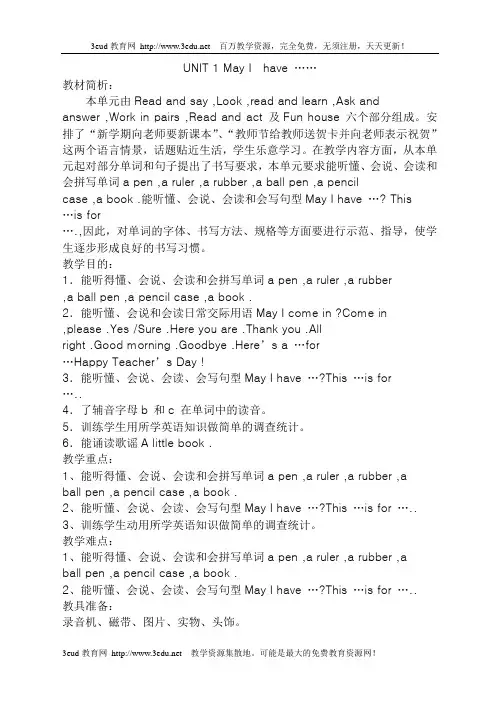
UNIT 1 May I have ……教材简析:本单元由Read and say ,Look ,read and learn ,Ask andanswer ,Work in pairs ,Read and act 及Fun house 六个部分组成。
安排了“新学期向老师要新课本”、“教师节给教师送贺卡并向老师表示祝贺”这两个语言情景,话题贴近生活,学生乐意学习。
在教学内容方面,从本单元起对部分单词和句子提出了书写要求,本单元要求能听懂、会说、会读和会拼写单词a pen ,a ruler ,a rubber ,a ball pen ,a pencilcase ,a book .能听懂、会说、会读和会写句型May I have …? This…is for….,因此,对单词的字体、书写方法、规格等方面要进行示范、指导,使学生逐步形成良好的书写习惯。
教学目的:1.能听得懂、会说、会读和会拼写单词a pen ,a ruler ,a rubber,a ball pen ,a pencil case ,a book .2.能听懂、会说和会读日常交际用语May I come in ?Come in,please .Yes /Sure .Here you are .Thank you .Allright .Good morning .Goodbye .Here’s a …for…Happy Teacher’s Day !3.能听懂、会说、会读、会写句型May I have …?This …is for…..4.了辅音字母b 和c 在单词中的读音。
5.训练学生用所学英语知识做简单的调查统计。
6.能诵读歌谣A little book .教学重点:1、能听得懂、会说、会读和会拼写单词a pen ,a ruler ,a rubber ,aball pen ,a pencil case ,a book .2、能听懂、会说、会读、会写句型May I have …?This …is for …..3、训练学生动用所学英语知识做简单的调查统计。
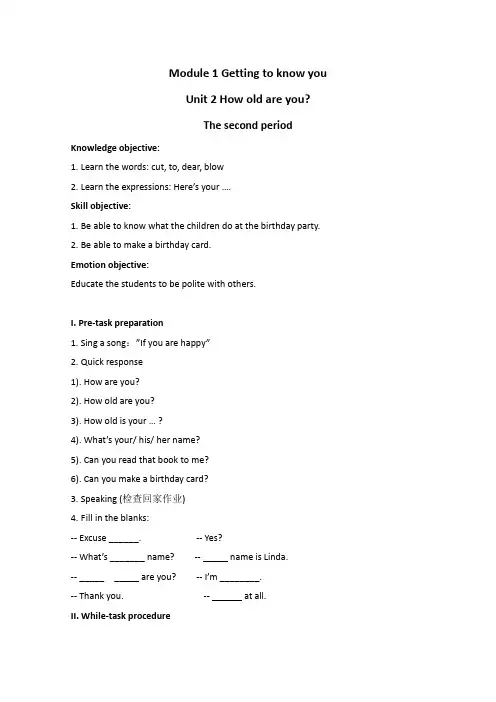
Module 1 Getting to know youUnit 2 How old are you?The second period Knowledge objective:1. Learn the words: cut, to, dear, blow2. Learn the expressions: Here’s your ….Skill objective:1. Be able to know what the children do at the birthday party.2. Be able to make a birthday card.Emotion objective:Educate the students to be polite with others.I. Pre-task preparation1. Sing a song:”If you are happy”2. Quick response1). How are you?2). How old are you?3). How old is your … ?4). What’s your/ his/ her name?5). Can you read that book to me?6). Can you make a birthday card?3. Speaking (检查回家作业)4. Fill in the blanks:-- Excuse ______. -- Yes?-- What’s _______ name? -- _____ name is Linda.-- _____ _____ are you? -- I’m ________.-- Thank you. -- ______ at all.II. While-task procedure(一) Words:1. Listen and spellsnow show slow blownear fear tear dear2. Explain and practice:dear: dear Mum/ mother; dear Dad/ mather dear Kitty; dear children blow: blow the candle The wind blows and blows.cut: cut the cake; cut the paper; cut the grass; cut the apple(二) Sentence pattern:1. Read the sentences: -- Here’s your cake.-- Thank you.2. Substitution drills:sweet paint ruler dress coat umbrella(三) Text:1. Listen to the text and answer: Whose birthday is today?(Sing the song with the tape.)2. Read the text.3. T: What do you do at the birthday party?Discuss and learn to say:make a wish; blow out candles; sing a birthday song; eat birthday cakel;sing a birthday song; play computer games; open presents4. Let’s chant (Cambrige English):Birthday, birthday, when’s your birthday?Not today, not today, my birthda y isn’t today.Whose birthday is it today?It’s Sam’s birthday. It’s Sam’s birthday.Birthday, birthday, when’s your birthday?It’s today. It’s today. Today’s my birthday.Happy birthday! Happy birthday!Thank you very much. Let’s eat the birthday cake.Le t’s eat the birthday cake.(四) Make a birthday card:1. Fold the card.2. Draw a picture on the card.3. Write: Dear AliceHappy Birthday!From KittyIII. Post-task activity1. Listen and fill in the blanks:Today’s Peter’s birthday. He’s in the garden with his parents. They’re having a birthday party. Bill and Tom are there, too. Now they’re eating the cake. Peter is opening his present. He is very happy.2. Read the passage.IV. Homework1. Read the text.2. Copy the words and text.3. Make a birthday card.。
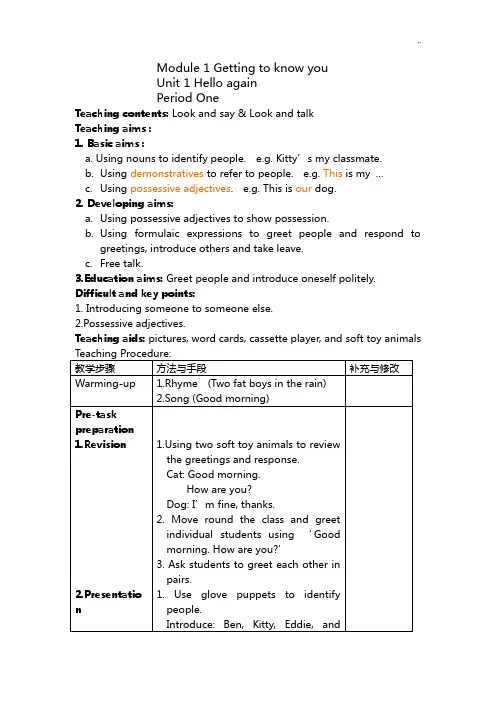
Module 1 Getting to know youUnit 1 Hello againPeriod OneTeaching contents: Look and say & Look and talkTeaching aims :1. Basic aims :a. Using nouns to identify people. e.g. Kitty’s my classmate.ing demonstratives to refer to people. e.g. This is my …ing possessive adjectives. e.g. This is our dog.2. Developing aims:ing possessive adjectives to show possession.ing formulaic expressions to greet people and respond togreetings, introduce others and take leave.c.Free talk.cation aims: Greet people and introduce oneself politely. Difficult and key points:1. Introducing someone to someone else.2.Possessive adjectives.Teaching aids: pictures, word cards, cassette player, and soft toy animalsPeriod TwoTeaching contents: Read a story & Learn the soundTeaching Aims:1.Basic aims:ing verbs to describe actions. e.g. run, swim, jumping modals to talk about ability. e.g. She can run.ing connectives to link contrasting ideas e.g. But she can’tcook.d.Saying the sound ‘ch-‘2. Developing aims:a. Read and act the storyb. Talking about ability.c. Write a simple story.Teaching aids: pictures, word cards, cassette player, and maskPeriod ThreeTeaching contents: Look and say & Ask and answerTeaching aims:1.Basic aims:a. Using verbs to describe actions. e.g. paint, readb. Using interrogatives to ask ‘yes/no’-questions to obtain simpleresponses. e.g. Can you swim?c. Using modals to talk about ability.e.g. Yes, I can. / No, I can’t.2 .Developing aims:a. Asking about ability.b. Do a survey in class.cation aims: Talking about ability to establish friendly relations withyour classmates.Teaching aids: pictures, word cards, cassette player,Module 1 Getting to know youUnit 2 How old are you?Period OneTeaching contents: Look and say. Ask and answer Teaching aims:1.Basic aim: 能听懂,会说,会读本课对话. E.g. How old …? Happybirthday. Thank you.2.Education aim: 会相互询问对方年龄,庆贺对方生日,增进感情。
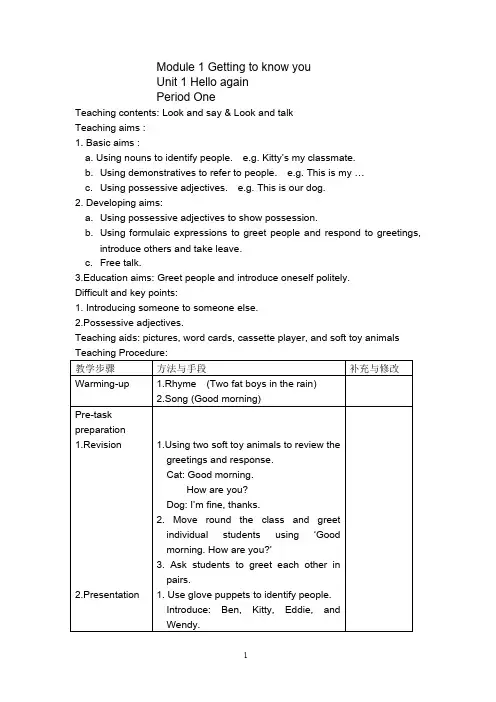
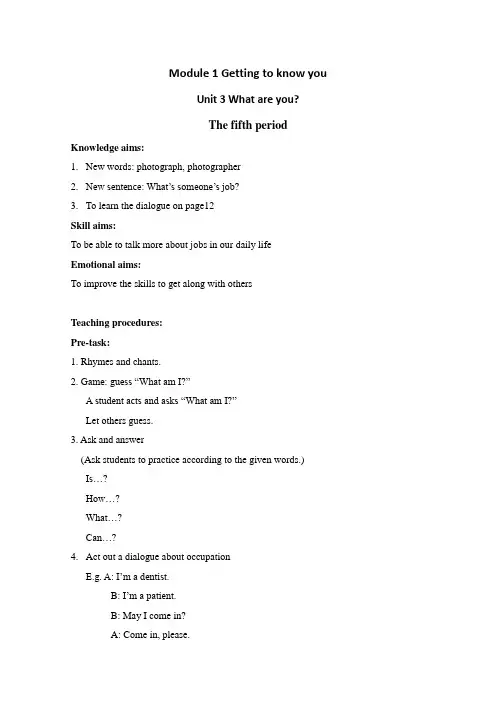
Module 1 Getting to know youUnit 3 What are you?The fifth period Knowledge aims:1.New words: photograph, photographer2.New sentence: What’s someone’s job?3.To learn the dialogue on page12Skill aims:To be able to talk more about jobs in our daily lifeEmotional aims:To improve the skills to get along with othersTeaching procedures:Pre-task:1. Rhymes and chants.2. Game: guess “What am I?”A student acts and asks “What am I?”Let others guess.3. Ask and answer(Ask students to practice according to the given words.)Is…?How…?What…?Can…?4.Act out a dialogue about occupationE.g. A: I’m a dentist.B: I’m a patient.B: May I come in?A: Come in, please.B: Good morning, Mr. Li.A: What’s the trouble?B: I have a toothache.A: Let me have a look. Please open the mouth, say “Ah”…5.Read and write “T” or “F”Hello. My Name is Grace. I’m ten years old. I’ve got a brother. His name is David. He is 18 years old. He is tall and fat. My father is a shop assistant. He can draw well. My mother is a waitress. She can cook.( ) There are three people in Grace’s family.( ) David is Grace’s father.( ) Grace’s mother is a shop assistant.( ) Grace’s brother is big and tall.( ) Grac e’s mother can cook.While-task:I. New words learning:1.photographT: Look! What’s this?It’s a photograph. It’s a photograph of my family.1)Complete the word: _ _otogra_ _2)Read3)Make sentences or phrases with “photograph”2.photographerT: Look! This is my father. He can take photos very well. He’s a_________.1)(Show the word “photographer”) Look at the word of “photographer” and tryto read it.2)Read together.3)How about: read- sing- dive-II. New sentence: What’s someone’s job?T: Do you kno w my father’s job now? What’s my father’s job? It means “Whatdoes my father do?” “What is my father?”S: He’s a photographer.1.Show the new sentence2.Read together.3.Ask your deskmate’s family member’s job with the new sentence.III. Dialogue1.Listen to the tape2. Answer some questions about the dialogue.3. Read after the tape together.4.Practice the dialogue in groups.Post-task:1. Act out this dialogue.2. Make a new dialogue according to the dialogue on the text book.3. Do a survey on your classmates’family members’ jobs and so on and have a reportbased on your survey.。
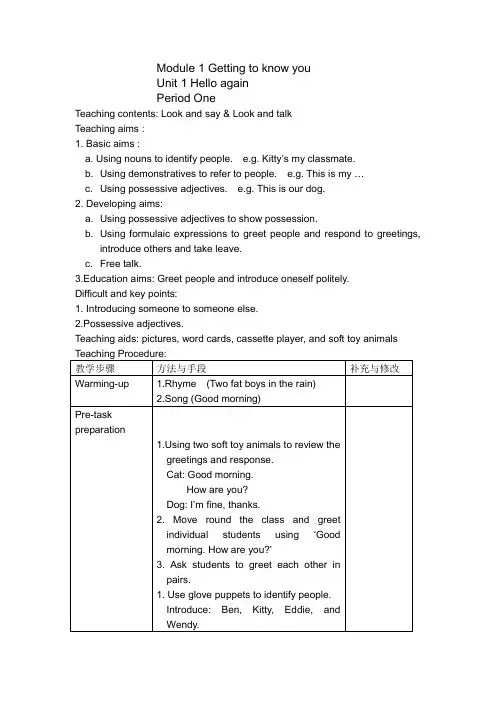
Module 1 Getting to know youUnit 1 Hello againPeriod OneTeaching contents: Look and say & Look and talkTeaching aims :1. Basic aims :a. Using nouns to identify people. e.g. Kitty’s my classmate.b. Using demonstratives to refer to people. e.g. This is my …c. Using possessive adjectives. e.g. This is our dog.2. Developing aims:a. Using possessive adjectives to show possession.b. Using formulaic expressions to greet people and respond to greetings,introduce others and take leave.c. Free talk.cation aims: Greet people and introduce oneself politely.Difficult and key points:1. Introducing someone to someone else.2.Possessive adjectives.Teaching aids: pictures, word cards, cassette player, and soft toy animalsPeriod TwoTeaching contents: Read a story & Learn the soundTeaching Aims:1. Basic aims:a. Using verbs to describe actions. e.g. run, swim, jumpb. Using modals to talk about ability. e.g. She can run.c. Using connectives to link contrasting ideas e.g. But she can’t cook.d. Saying the sound ‘ch-‘2. Developing aims:a. Read and act the storyb. Talking about ability.c. Write a simple story.Teaching aids: pictures, word cards, cassette player, and maskPeriod ThreeTeaching contents: Look and say & Ask and answerTeaching aims:1.Basic aims:a. Using verbs to describe actions. e.g. paint, readb. Using interrogatives to ask ‘yes/no’ -questions to obtain simple responses.e.g. Can you swim?c. Using modals to talk about ability.e.g. Yes, I can. / No, I can’t.2 .Developing aims:a. Asking about ability.b. Do a survey in class.cation aims: Talking about ability to establish friendly relations with yourclassmates.Teaching aids: pictures, word cards, cassette player,Module 1 Getting to know youUnit 2 How old are you?Period OneTeaching contents: Look and say. Ask and answerTeaching aims:1.Basic aim: 能听懂,会说,会读本课对话. E.g. How old …? Happybirthday. Thank you.2.Education aim: 会相互询问对方年龄,庆贺对方生日,增进感情。
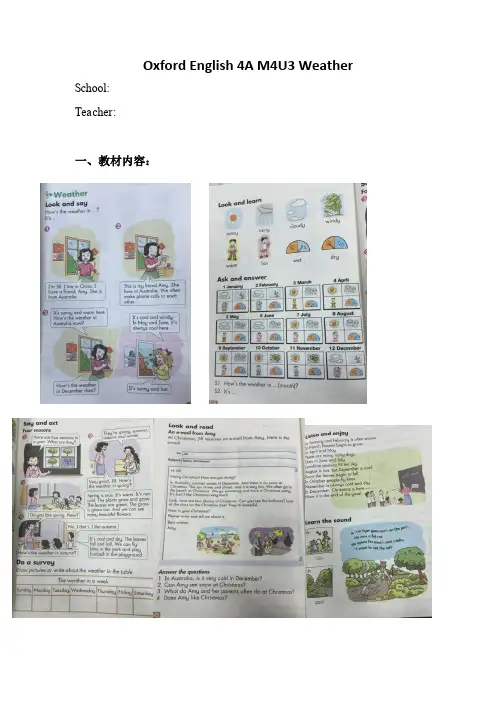
Oxford English 4A M4U3 Weather School:Teacher:一、教材内容:二、单元教学目标:【语用任务】在Jill介绍自己家乡上海一年中各个月份的不同天气的情境中,能够对不同月份的天气进行提问并且做出回答;在Jill与来自澳大利亚、英国、新加坡的朋友通信的情境中,能够对比不同国家的不同天气,并且能够撰写电子邮件介绍自己国家的天气;在Jill课堂学习的情境中,关注到不同季节的不同气候,并且对自己喜欢的季节做出较完整的描述。
内容完整,表达流利,拼写及语法基本正确。
●语言知识与技能1、能够正确认读、理解和运用核心词汇sunny, rainy, windy, warm, hot, wet, January, February, March, April, May, June, July, August, September, October, November, December, China, Australia, always,做到音、形、义的统一;能关注到不同季节、不同月份的不同天气。
2、能够运用特殊疑问句How’s the we ather in …?来询问不同季节、地区的天气情况,并能够根据实际情况做出相应的回答:It’s ...3、能够运用已学过的句型What are they?和Do you like...? 等句型询问他人对季节、月份的了解状况。
4、能够听辨字母组合“th- ”在单词thin, think, path等词汇中的正确发音。
●语言情感通过学习了解不同国家、不同季节和不同月份的不同天气,培养学生观察生活的能力,通过与来自不同国家朋友的对话和电子邮件中,了解不同国家的不同天气,提高文化意识,激发学生热爱生活的感情。
●学习策略通过学生欣赏、对话、读诗、小组活动、写电子邮件等多种形式,完成语段输出,达到语言运用的目的。
四、单课教学目标4AM4U3 WeatherDifferent countries, different weather (Period 2)一、第二课时文本主体文本I’m Jill. I live in China. It’s December now. It’s cold and cloudy in Shanghai. We can go to the gym. It’s sunny and hot in May and June. We can go to the beach and go swimming. And in March, it’s often warm. We can ride a bicycle. In September and October, it’s windy and cool. We can fly a kite.I have a friend, Amy. She is from Australia.Jill: Hello! This is Jill.Amy: Hello, Jill! This is Amy. How’s the weather in China?Jill: It’s cold and cloudy. How’s the weather in Australia now?Amy: It’s sunny and hot. We can go to the beach.Jill: How’s the weather in May and June then?Amy: It’s cool and windy. In May and June, it’s always cool here. We can fly a kite.Tony: Hello! This is Tony.Jill: Hello, Tony! This is Jill.Tony: I’m your new friend in the UK. My hometown is very nice. It always snows in December. We can make a snowman. How’s the weather in China now?Jill: It’s cold and windy. We can fly a kite.Tony: Wow! It’s fun!Jill: Thanks for calling. See you!Tony: See you!An e-mail from Emma.To: JillSubject: The weather in SingaporeHi, Jill.I’m Emma. I live in Singapore. It’s December now. It’s warm and rainy in Singapore. We can go to the park. In May and June, it’s sunny and hot. We can go to the beach and make sandcastles there. In September, it’s cool. It’s beautiful.How’s the weather in China? Please write and tell me about it. Your friend,Emma预设输出语言:The weather in ______________ is very beautiful.It’s ______ (month) now.It’s _____ and _____.We can __________.Sometimes it’s _______.We can _________.How _______!二、第二课时教学过程三、第二课时课堂练习设计。
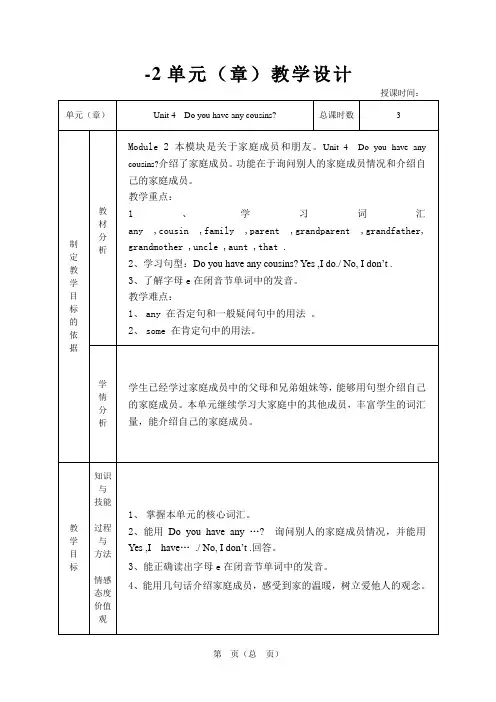
-2单元(章)教学设计
授课时间:
第页(总页)
课时教学设计首页
第页(总页)
课时教学流程
发音也很难
和拼音相结
合,单词发
音教学有难
度。
只能结合以
前积累的单
词发音规律
来进行单词
发音的教
学。
第页(总
页)
课时教学设计尾页(试用)
That pen
This pen
My cousin
第页(总页)
课时教学设计首页
第页(总页)
课堂变化及处理 主要环节的效果 补 充
课时教学流程
介绍家人是旧句型,重点在于有关h a ve 的一般疑问句及其回答。
句型属于新句型,又内含新单词,比较复杂,整句拆开进行教学,套用句型重复练习。
第 页(总 页)
课时教学设计尾页
第页(总页)
金胜镇“新模式”常规要求之一
课时教学设计首页(试用)
授课时间:2014 年10月16 日
第页(总页)
课堂变化及处理 主要环节的效果 补 充
课时教学流程
通过课文学习如何介绍自己的家人,介绍年龄,姓名,职业,能力。
重点句型体现了一组问答,让学生知道如何运用。
使用拼音发音的教学法,学习字母e 的元音发音,引导学生自己发音。
第 页(总 页)
课时教学设计尾页(试用)
第页(总页)。
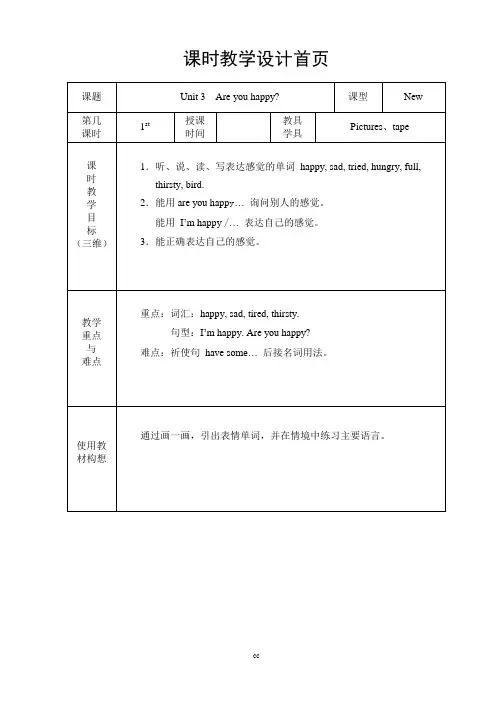
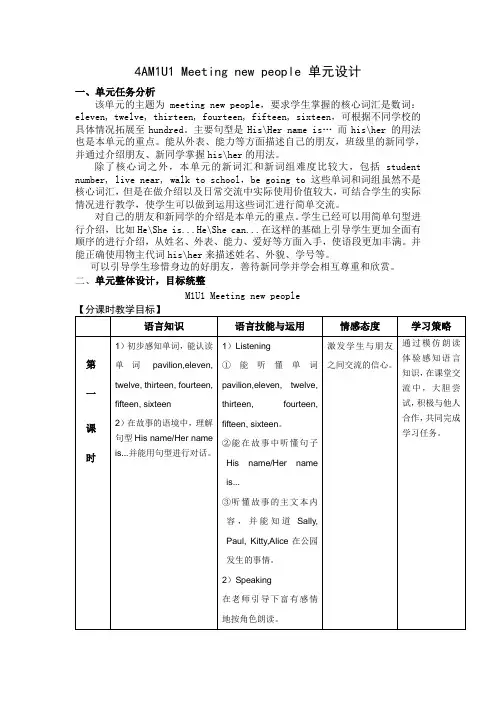
4AM1U1 Meeting new people 单元设计一、单元任务分析该单元的主题为meeting new people,要求学生掌握的核心词汇是数词:eleven, twelve, thirteen, fourteen, fifteen, sixteen,可根据不同学校的具体情况拓展至hundred。
主要句型是His\Her name is…而his\her 的用法也是本单元的重点。
能从外表、能力等方面描述自己的朋友,班级里的新同学,并通过介绍朋友、新同学掌握his\her的用法。
除了核心词之外,本单元的新词汇和新词组难度比较大,包括student number, live near, walk to school,be going to这些单词和词组虽然不是核心词汇,但是在做介绍以及日常交流中实际使用价值较大,可结合学生的实际情况进行教学,使学生可以做到运用这些词汇进行简单交流。
对自己的朋友和新同学的介绍是本单元的重点。
学生已经可以用简单句型进行介绍,比如He\She is...He\She can...在这样的基础上引导学生更加全面有顺序的进行介绍,从姓名、外表、能力、爱好等方面入手,使语段更加丰满。
并能正确使用物主代词his\her来描述姓名、外貌、学号等。
可以引导学生珍惜身边的好朋友,善待新同学并学会相互尊重和欣赏。
二、单元整体设计,目标统整M1U1 Meeting new people【第一课时教学设计】Meeting new people at the EXPO一、教学目标1. Words: eleven, twelve, thirteen, fourteen, fifteen, sixteen...2. Structure: His\Her name is...His\Her student number is ...二、教学重点与难点1. The usage of nouns to identify people.2. Using possessive pronouns to introduce one’s name and gesture.三、教育技术与学习资源应用PPT、黑板、故事卡片、视频支持四、本课时文本内容Nice to meet you too. Welcome to Shanghai. My Name’s _____. I’m …五、教学过程【第二课时教学设计】 A new classmate一、教学目标1. New words:live, near, walk, Sally, Paul, Jill, Poe and Rose2. Phrases: be going to, walk to, play well, every day3. Using the modeled sentences to ask and answerWhat about you, ___? I’m ___.4. Using modeled sentences to make a new dialogue about different persons5. Using formulaic expressions to describe their friends6. Helping the students introduce their friends, classmates or parents.二、教学重点与难点1. Reading and spelling the words and phrases correctly.2. Using wh-questions to find out different information.3. Using modeled sentences to ask and answer about fancy.4. Saying and using the phrases correctly and fluently5. Using modeled sentences to describe the one they like best三、教育技术与学习资源应用PPT、黑板、故事卡片、视频支持五、本课时文本内容Hello, My name is Peter. I’m ten years old. My student number is eighteen.I like playing.I can play football well. This is my sister. Her name is Sally. She’s twelve. And this is my brother. His name is Paul. He is only six. We are going to the park.五、教学过程【第三课时教学设计】About Jill一、教学目标and spell the words correctly: mask ,ask , laugh, smilethe phrases fluently: put on, welcome toa short dialogue with the sentences that the text gives.the pronunciation of “-sk” in words such as desk and mask.the modeled sentences to introduce somebody.modeled sentences to make a new dialogue about different personsformulaic expressions to describe their friends.the students introduce their friends, classmates or parents.二、教学重难点1. Use wh-questions to find out different information2. Use modeled sentences to ask and answer about fancy三、教育技术与学习资源应用PPT、黑板、故事卡片、视频支持四、本课时文本内容We have a new classmate, Jill. She’s ten years old. She lives near our school. She walks to school every likes reading, and she can play basketball well. She can dance likes dancing.五、教学过程Teaching aids: Multi-media。
Module 1 Getting to know youUnit 3 What are you?The Second PeriodLanguage focus:Knowledge objective:ing nouns to identify people (doctor, waiter…)2.Asking ‘Wh-‘ questions to find out a person’s identity.(What’s he/she?)3.Saying the sounds. ’ph-’ ‘wh-‘.Skill objective:Read the words correctly.Emotion objective:了解不同职业的作用,明白职业不分贵贱。
Materials:Student’s Book 4A page 9MediaTeaching procedures:I. Pre-task preparation:A. Read a rhyme.B. Ask & answersII. While-task procedureWords: doctor, dentist, nurseShow the picture of the hospital.What can you see in the hospital?Doctor, dentist, nurseRead the words.Dog—doctorDesk-dentistPurse-nurseTalk about the doctor, nurse, dentist.Doctor, doctor, a clever doctor.Nurse, nurse, clean nurses.Dentist, dentist, brave dentists.What can they do?Words: shop assistant, waiter, waitress, bus-driverYou want to buy something. Who can help you?You’re hungry. You want to eat something. Who can help you?Read the words.waiter, waitress.—actor, actressC. Getting to know the names of jobsfire+man---firemanpolice+man/woman---policeman/policewomanambulance+man---ambulance manshop+assistant---shop assistantbus+driver---bus-driverpost+man---postman(课中有不少表示职业的名词,其中一些是复合词)D. Say something about them.1). Write the following three groups of words on the board:bus-driver helps sick peoplepoliceman drives a busdentist looks after criminalsdoctor arrests peoples’ teeth2). Get the learners to make sentences with words from the three groups , for example:( Have a discussion in groups of four)A bus-driver drives a bus.Ask and answer.What is your father?...(Learn the words: worker, clerk, engineer, manager)III. Post-task activitiesQuick response.(Look at the pictures.) What’s he/she?Do a survey.Talk about your family.Learn the sounds.Ph/f/ photo, telephone, Philip, phone.Wh/w/ what , where, white, whale, whichIV. HomeworkListen and read on page 9.Copy the words and sentences.Talk about the professions with your friends.。
4AM1U1 Meeting new people 单元设计(主备人:)单元任务分析该单元的主题为meeting new people,要求学生掌握的核心词汇是数词:eleven, twelve, thirteen, fourteen, fifteen, sixteen,可根据不同学校的具体情况拓展至hundred。
主要句型是His\Her name is…而his\her 的用法也是本单元的重点。
能从外表、能力等方面描述自己的朋友,班级里的新同学,并通过介绍朋友、新同学掌握his\her的用法。
除了核心词之外,本单元的新词汇和新词组难度比较大,包括student number, live near, walk to school,be going to 这些单词和词组虽然不是核心词汇,但是在做介绍以及日常交流中实际使用价值较大,可结合学生的实际情况进行教学,使学生可以做到运用这些词汇进行简单交流。
对自己的朋友和新同学的介绍是本单元的重点。
学生已经可以用简单句型进行介绍,比如He\She is...He\She can...在这样的基础上引导学生更加全面有顺序的进行介绍,从姓名、外表、能力、爱好等方面入手,使语段更加丰满。
并能正确使用物主代词his\her来描述姓名、外貌、学号等。
可以引导学生珍惜身边的好朋友,善待新同学并学会相互尊重和欣赏。
单元教学目标通过本单元的学习,学生能:1.掌握数词eleven, twelve, thirteen, fourteen, fifteen, sixteen,能认读一百以内的整数;2.复习招呼语的各种表达;3.能使用his\her等物主代词描述一个人的名字,外表,学号等等,如his hair\eyes…4.正确使用词组:student number, live near, walk to school,be going to5.了解和感知-sk在单词中的发音,并能正确发【sk】。
牛津小学英语4A Unit4教学案例优秀3篇牛津小学英语4A Unit4教学案例篇一教学内容:牛津小学英语4a unit4i like…第一课时教学目标:(一)认知目标:1.能听说读写单词:car,bus,bike,kite2.能听说读单词:puppet,puzzle,doll,balloon3.能听说读写句型:do you like…?以及回答yes,i do./no, i don’t..(二)能力目标:能正确掌握单词及句型进行简单的交流(三)情感目标:能激发学生的兴趣,培养其交际能力教学重点:单词的发音以及句子的理解,并能灵活运用教学难点:1.like后面加名词的复数2.各种名词变复数后的读音教学准备:1.教具准备:实物,图片,多媒体课件2.板书准备:课题unit4 i like…教学过程:step1: warming upa.greetingb.sing an english song perhapsc.free talk: what’s this in english?may i have this…?step2: presentation1.(课件,出示汽车图片)t: look at the picture,what's this in english?教授car,并且引导学生拼写2.(课件出示复数图片及句型)t: do you like cars? 引导学生回答:yes,i do./no, i don’t..引导学生发现like后面加复数,多种形式操练句型(如小组互问,同桌互问,男女生互问等)3.(出示公交车图片)t:is this a bus? s: no , it isn’t..it’s a bus.(教授bus)t: do you like buses?(重点教授buses的发音)4. (课件,出示部分图片)t: guess, what’s this? s: it’s a bike.(教授bike并操练句型,s-s,s-t)5.s: do you like bikes?t:no, i don’t. i like puzzles.(出示图片) look,what’s this in english?let’s listen to the tape.(教授puzzle)6.t: let’s do a puzzle.( 课件做拼图,洋娃娃)教授doll7.t: (课件)what’s in the doll’s hand?s: it’s a …t: a balloon.(教授balloon)8. t:(课件)look, the balloon has flew away. guess, where is it?s: perhaps it’s in the…t: perhaps it’s in the sky.(课件)look, is that a balloon?s: no , it isn’t..it’s a …t: yes , you are so clever. it’s a kite.(教授kite)9.t: next,let’s have a rest. let’s go to see a puppet show.look at this picture. do you know what’s this in english?s: it’s a …t:it’s a puppet.(教授puppet)(在新授单词和句型这一环节中,我精心设计了每一个单词的呈现方法,环环相扣,运用多种方法操练单词,如小组读,男女生读,开火车读,高低声读等,并且在每教授一个单词的过程中操练句型,做到词不离句)step3 consolidation1.game: a. what’s missing?b. do a puzzle(这两个游戏主要更进一步巩固单词,并且进行小组竞赛,激发学生的兴趣)2.t: do you like dolls?s: yes, i do.t: ok, we can buy a doll in a supermarket.shall we go to the supermarket?s: ok, let’s * *go.t: (出示实物)in the supermarket,there are a lot of thing. some toys, some fruits, some pencils and so on.3.示范对话:a: hello…!b: hello…!a: let’s go to the supermarket.b: ok!a: do you like…?b: yes, i do./no, i don’t.a: this …is for you.b: thank you.a: not at all.4.work in pairs and act the dialogue(创设场景,并且加入以前学过的水果,文具,玩具,食物类单词,整合对话,进一步体现了语言的实用性,给学生提供了体验成功的舞台)step 4 homework1.copy the new words .2.ask your father and mother what do they like.3.preview part a .教学反思:这节课我能以学生为主体,以培养学生的兴趣为情感目标,体现了语言的实用性和交际性,学生能基本掌握单词的发音,和句型的理解,教学难点也有所突破,学生能掌握like 后加名词的复数,但是由于单词教学花了过多的时间,最后的对话巩固显得有些匆忙。